SAPPHIRE PURE AMD Radeon RX 9070 XT Graphics Card Review
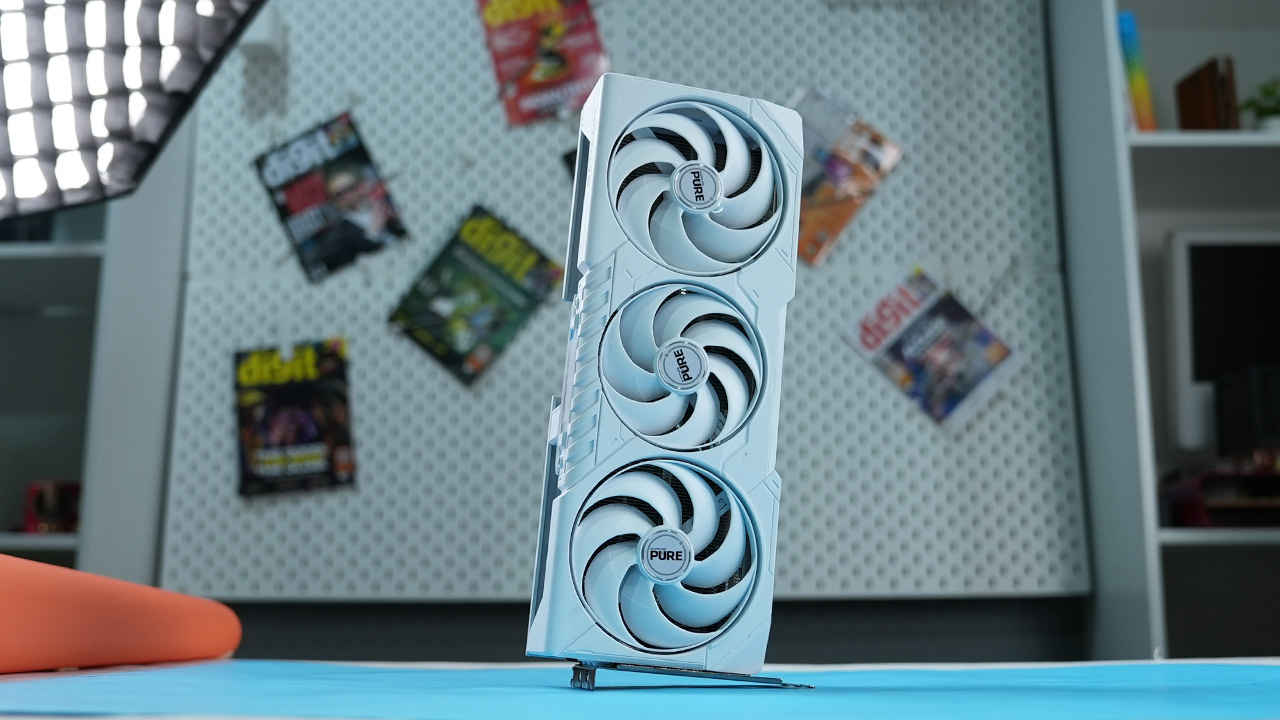
The Sapphire AMD Radeon RX 9070 XT graphics card is a powerful graphics card that offers excellent performance for 4K gaming and content creation. Based on AMD’s latest RDNA 4 architecture, the 9070 XT enjoys significant improvements in efficiency and performance over the previous generation RDNA 3 architecture. However, the compute efficiency comes at a tradeoff with power consumption and that’s quite high on the 9070 XT. Nevertheless, with 16 GB of VRAM on a 256-bit interface, improved ray-tracing performance and raster performance that matches and even beats the 7900 XTX, the Radeon 9070 XT has become a force to be reckoned with. If priced right at around INR 60,000 to 65,000, it offers excellent 4K gaming performance for the money. So if you’re looking for an upper-mid-range graphics card that won’t break the bank, the RX 9070 XT is a great option but if this card is priced anywhere above 80-85K then the NVIDIA RTX 5070 Ti becomes the better option considering that the performance-per-watt metric shifts in NVIDIA’s favour.
With the launch of the AMD Radeon RX 9070 XT, the company is going all out with their new RDNA 4 architecture with solid improvements to a lot of components aimed at not only increasing the raster performance but also AI performance. The company did state that it’s more focused on producing graphics cards for the high-volume market segments rather than gunning for leadership in the top-of-the-line segment. That being said, AMD does appear to have a solid contender for the upper-mid range segment with the RX 9070 XT and they’re going really aggressive with the pricing so as to not leave an inch of ground for the NVIDIA 5070 Ti and 5070 to tread on.
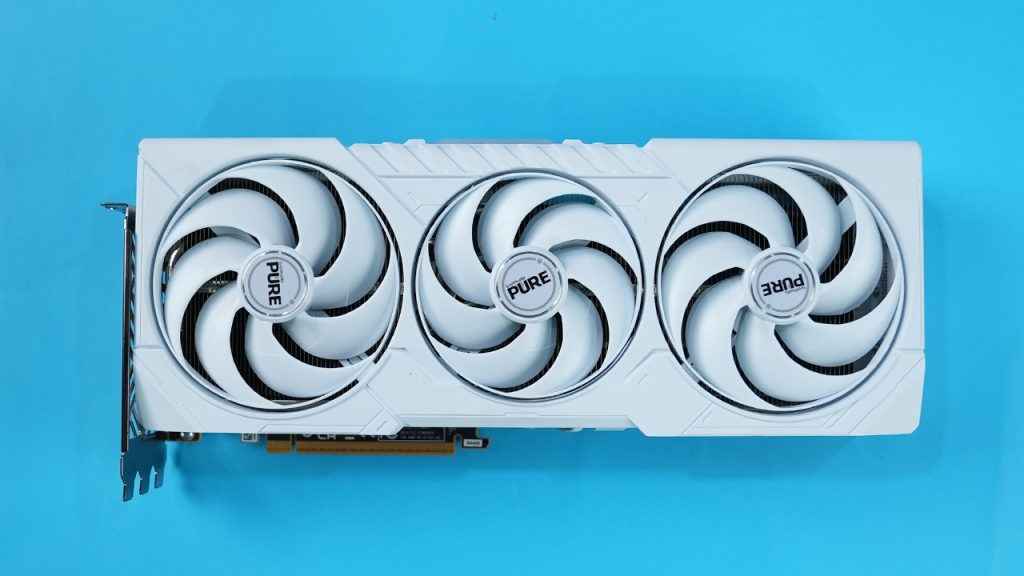
At a price point of USD 599, the AMD Radeon RX 9070 XT is not only undercutting the 5070 Ti but it also sets the stage for usurping market share for all the cards that will be positioned below it. We know that the Radeon RX 9060 XT and RX 9060 are next in line for launch but there’s no telling when they’ll hit the shelves. Moreover, declaring MSRP and actually selling the cards at MSRP are two completely different things, especially in India where retailers and wholesalers artificially inflate the prices. So will the Radeon RX 9070 XT sell for anywhere around INR 60,000-65,000? We’re not quite certain they will but we’ll know for sure in the coming days. AMD’s victory lap might be short-lived if the dealers don’t stick to MSRP pricing.
AMD Radeon RX 9070 XT Specifications
The AMD Radeon RX 9070 XT, built using the latest RDNA 4 architecture which was unveiled at CES 2025, features 64 Compute Units with a grand total of 4096 Shaders. It also packs two dedicated AI cores per Compute Unit. There are several other modifications to the architecture geared towards making it more efficient than the previous gen RDNA 3. AMD claims that the RX 9070 XT can match and even outperform the RDNA 3 flagship 7900 XTX in quite a few benchmarks as a result. One of the biggest bumps is the clock speeds which are now touching 3 GHz!
| AMD Radeon RX 9070 XT Specifications | |||||
| GPU | RX 7900 XTX | RX 7900 XT | RX 7900 GRE | RX 7800 XT | RX 9070 XT |
| Code Name | Navi 31 XTX | Navi 31 XT | Navi 31 | Navi 32 XT | Navi 48 XT |
| Shader Engines | 6 | 6 | 5/6 | 4 | 4 |
| Dual Compute Units | 48 | 42 | 40 | 30 | 32 |
| Compute Units | 96 | 84 | 80 | 60 | 64 |
| Shaders | 6144 | 5376 | 5120 | 3840 | 4096 |
| Shader FLOPS | 61.44 | 51.61 | 45.98 | 37.32 | 48.66 |
| Tensor/AI Cores | 0 | 0 | 0 | 0 | 128 |
| RT Cores | 96 | 84 | 80 | 60 | 64 |
| Texture Units | 384 | 336 | 320 | 240 | 256 |
| ROP Units | 192 | 192 | 192 | 96 | 96 |
| Base Clock | 1855 MHz | 1500 MHz | 1287 MHz | 1295 MHz | 2400 MHz |
| Boost Clock | 2499 MHz | 2394 MHz | 2245 MHz | 2439 MHz | 2970 MHz |
| Memory Clock | 2500 MHz | 2500 MHz | 2250 MHz | 2438 MHz | 2438 MHz |
| Memory Data Rate | 20 GB/s | 20 GB/s | 18 GB/s | 19.5 GB/s | 19.5 GBps |
| L0 Data per WGP | 64 KB | 64 KB | 64 KB | 32 KB | 32 KB |
| L1 Cache per Array | 256 KB | 256 KB | 256 KB | 128 KB | 128 KB |
| L2 Cache Size | 6 MB | 6 MB | 6 MB | 4 MB | 4 MB |
| L3 Cache Size | 96 MB | 80 MB | 64 MB | 64 MB | 64 MB |
| Total Video Memory | 24 GB | 20 GB | 16 GB | 16 GB | 16 GB |
| Video Memory Type | GDDR6 | GDDR6 | GDDR6 | GDDR6 | GDDR6 |
| Memory Interface | 384-bit | 320-bit | 256-bit | 256-bit | 256-bit |
| Total Memory Bandwidth | 960.0 GB/s | 800.0 GB/s | 576.0 GB/s | 624.1 GB/s | 624.1 GB/s |
| Process Node | TSMC N5 / N6 | TSMC N5 / N6 | TSMC N5 / N6 | TSMC N5 / N6 | TSMC N5 / N6 |
| Total Graphics Power | 355 W | 300 W | 260 W | 263 W | 304 W |
The Radeon RX 9070 XT introduces a balance of efficiency and performance improvements over its predecessor, the RX 7900 XTX, leveraging the RDNA 4 architecture. The RX 9070 XT features 16GB of GDDR6 memory with a 256-bit memory bus, while the RX 7900 XTX offers 24GB of GDDR6 memory with a wider 384-bit memory bus. This gives the RX 7900 XTX higher overall bandwidth, beneficial for workloads requiring high memory throughput. However, AMD has implemented improved memory compression in the RX 9070 XT, which helps mitigate the bandwidth deficit.
One of the major advantages of the RX 9070 XT is its improved power efficiency. The RX 9070 XT operates with a board power of 304W, significantly lower than the RX 7900 XTX’s 355W. And it does so while introducing newer features such as the 3rd Gen Ray Tracing Accelerators, which promise twice the ray traversal efficiency compared to the 2nd Gen Ray Tracing Accelerators found in the RX 7900 XTX. A significant upgrade in the RX 9070 XT is the inclusion of 2nd Gen AI Accelerators, which bring substantial improvements in AI-driven workloads, such as upscaling and frame generation. The RX 7900 XTX lacks advanced AI acceleration to the same extent, meaning it may not fully leverage modern AI-powered upscaling technologies like AMD’s FSR 4 to the same degree as the RX 9070 XT. The RX 9070 XT is an efficient and AI-ready alternative to the RX 7900 XTX. While it does not surpass its predecessor in pure rasterisation performance, it compensates with better ray tracing, improved AI acceleration, and superior power efficiency.
AMD Radeon RX 9070 XT Performance
We have featured the recently launched NVIDIA RTX 50 series cards along with some of the RTX 40 series cards including the Super cards. A few older series cards from AMD such as the 7900 XTX were also thrown into the mix to see how good the cards perform against the competition. It’s interesting to see how the pair-ups of the AMD Radeon RX 9070 XT vs RTX 5070 vs RX 7900 XTX vs RTX 5070 Ti vs RTX 4080 Super vs RTX 5080 will pan out. Like always, we have a section for synthetic benchmarks as well as gaming benchmarks, with plenty of charts to showcase differences. Coming to the rig, this is what we’re running our benchmarks on.
Processor – AMD Ryzen 7 9800X3D
CPU-Cooler – Noctua NH-D15
RAM – 2x 32 GB Kingston FURY Beast 6000 MT/s
SSD – Kingston KC3000 2TB
PSU – Cooler Master V1200
3DMark
3DMark is a popular benchmarking tool for graphics cards and gaming systems. It provides a comprehensive suite of tests that measure various aspects of a GPU’s performance. 3DMark includes several benchmarks, such as Time Spy, Steel Nomad, Speed Way, and Fire Strike. Time Spy is a DirectX 12 benchmark that tests the performance of a GPU and CPU in a variety of graphically demanding scenes. Steel Nomad, successor to Time Spy, is a DirectX 12 benchmark that focuses on real-time ray tracing and other advanced graphics features. Then there’s Speed Way, a DirectX 12 benchmark designed to test the performance of a GPU and CPU in a high-speed racing game environment. And for legacy benchmarks, we have Fire Strike which is a DirectX 11 benchmark that tests the performance of a GPU and CPU in a variety of gaming scenes.
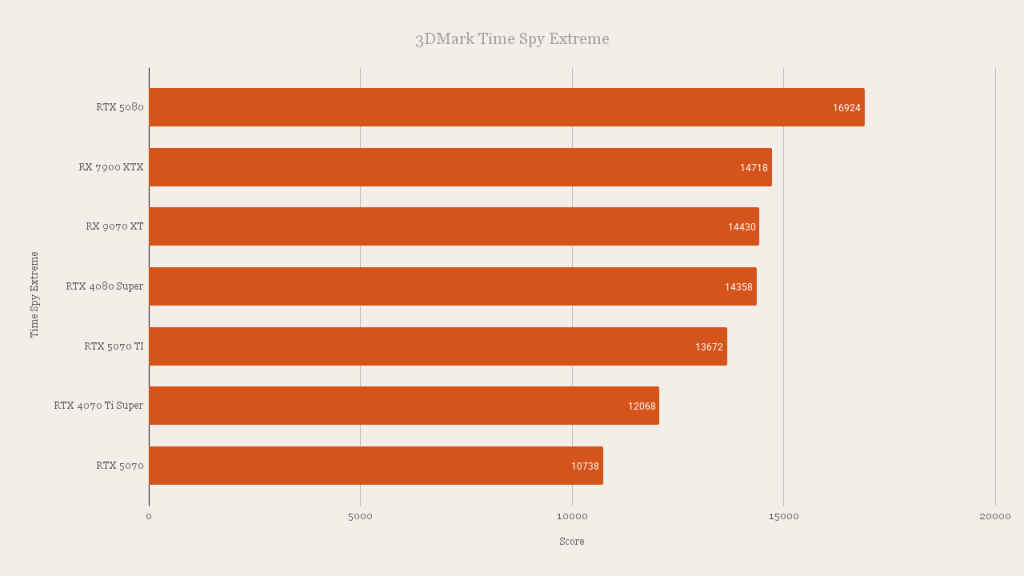
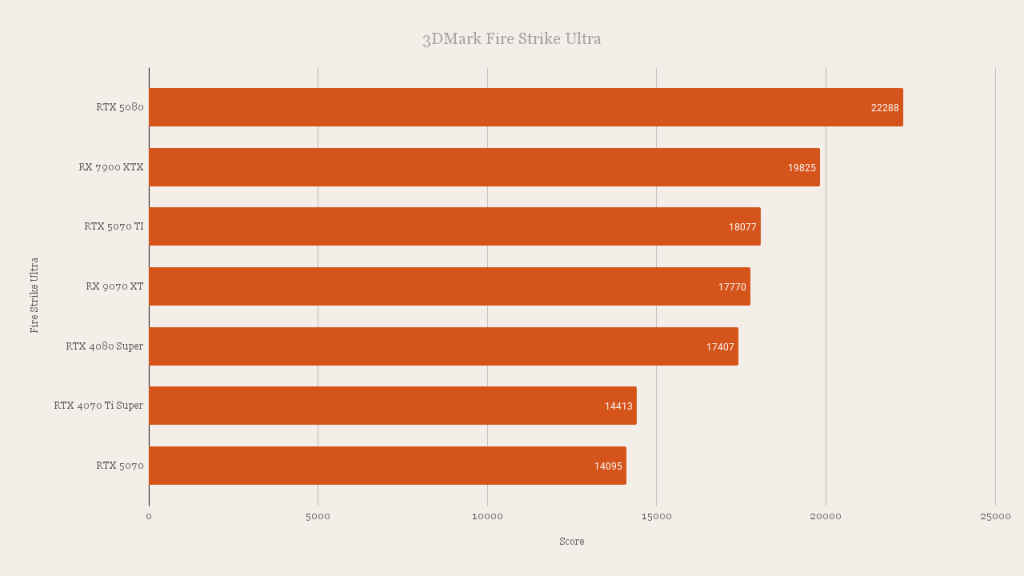
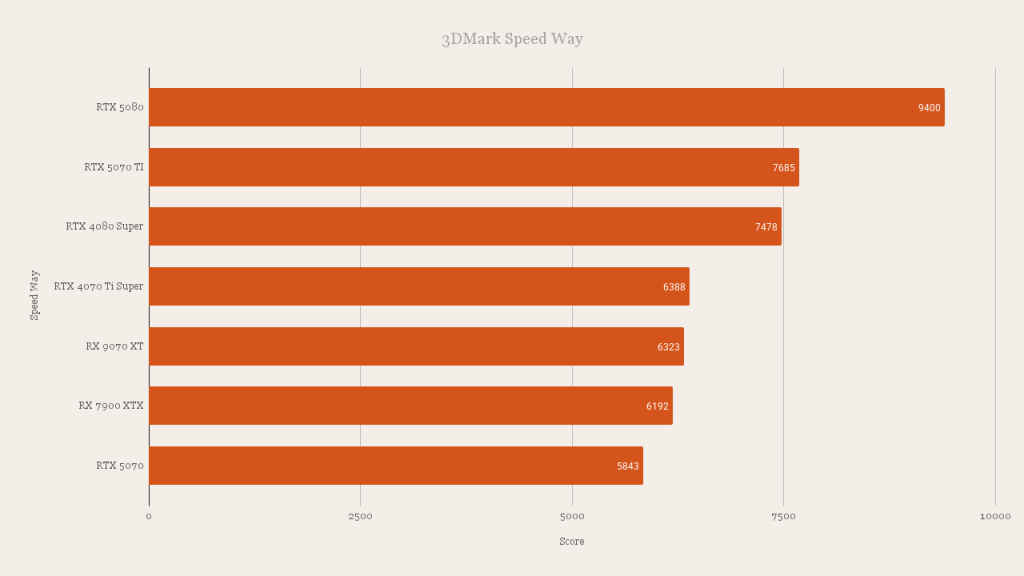
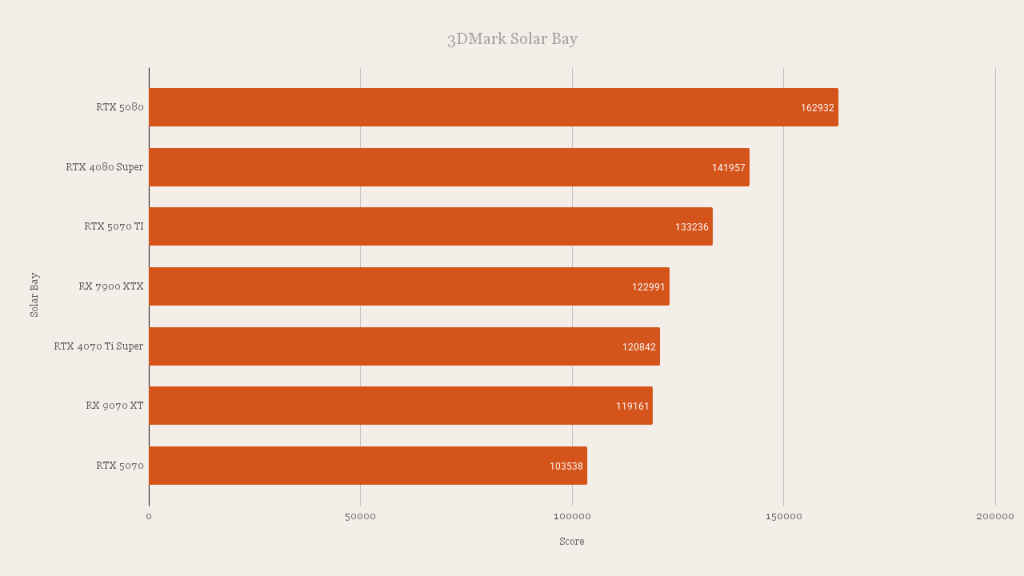
Ray Tracing
3DMark Port Royale is a synthetic benchmark that uses a real-time ray tracing scene to simulate the reflections, shadows, and other visual effects that are possible with ray tracing technology. Port Royale is a demanding benchmark that can be used to compare the performance of all current graphics cards with real-time hardware-accelerated ray-tracing.
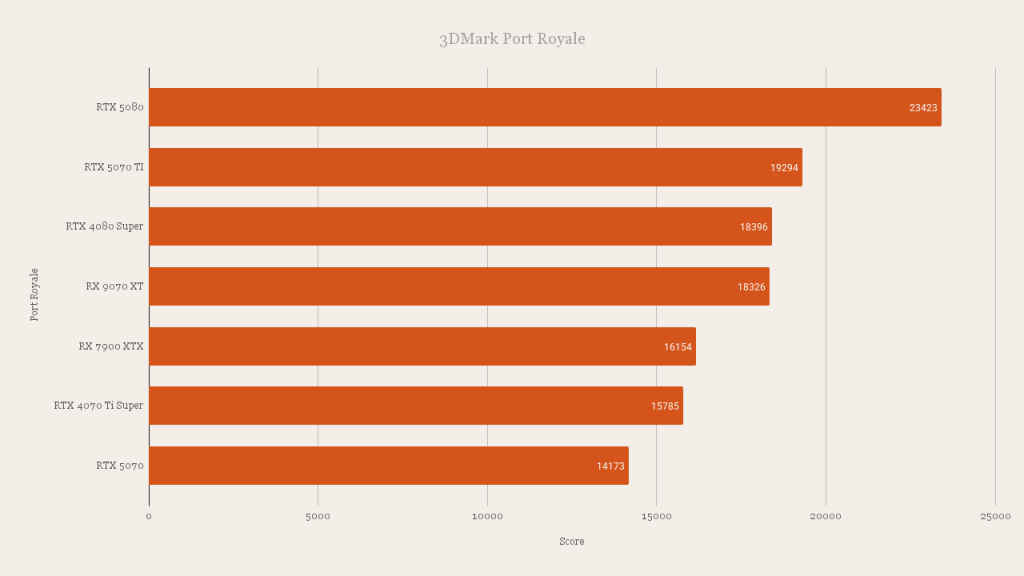
3DMark Port Royale
OpenCL Rendering
This benchmark utilises OpenCL to generate photorealistic results by strictly adhering to the physics of light, a process known as physically-based rendering. Rendering progress is gauged by the number of samples calculated, which can be visualised as “light particles” that have interacted with the scene and reached the camera’s sensor. As a physically-based renderer, the results closely reflect how GPUs are used in industrial rendering applications.
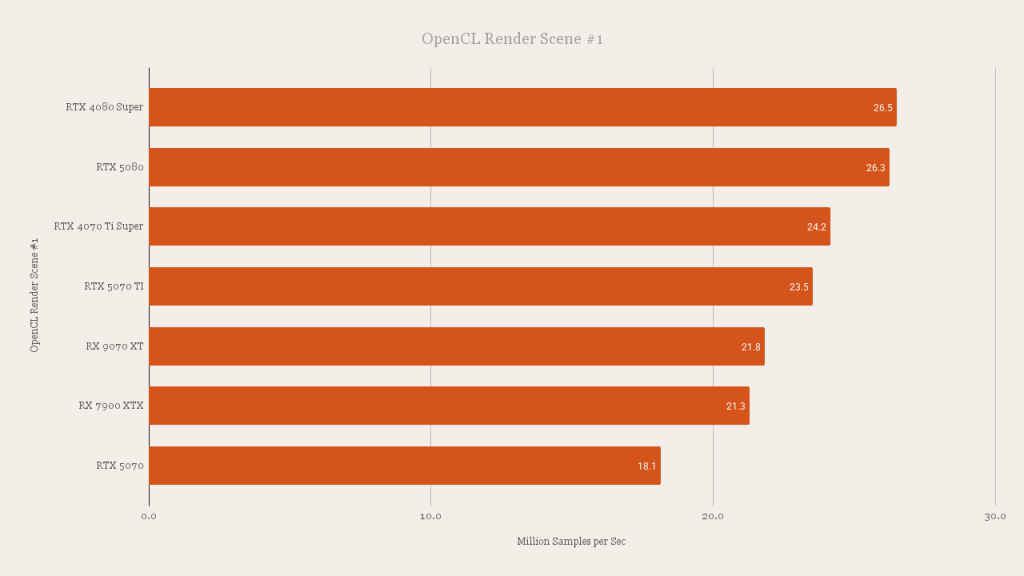
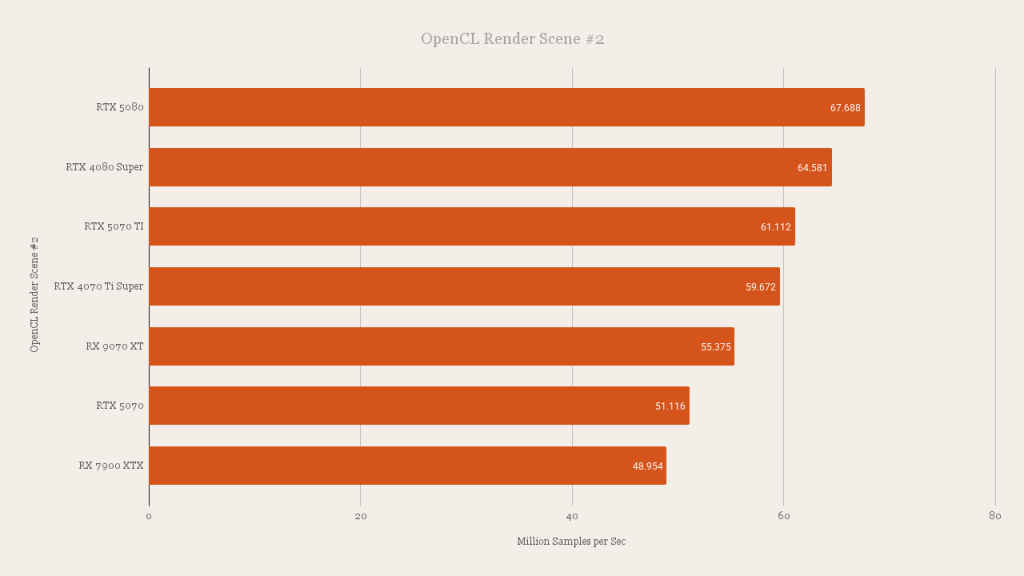
API Performance
Basemark GPU is a nice benchmark to compare the performance of different graphics APIs between cards. We can use the same textures with OpenGL, Vulkan and DirectX 12 to see if the graphics card excels at any particular API more than the rest or if the performance is consistent across the board.
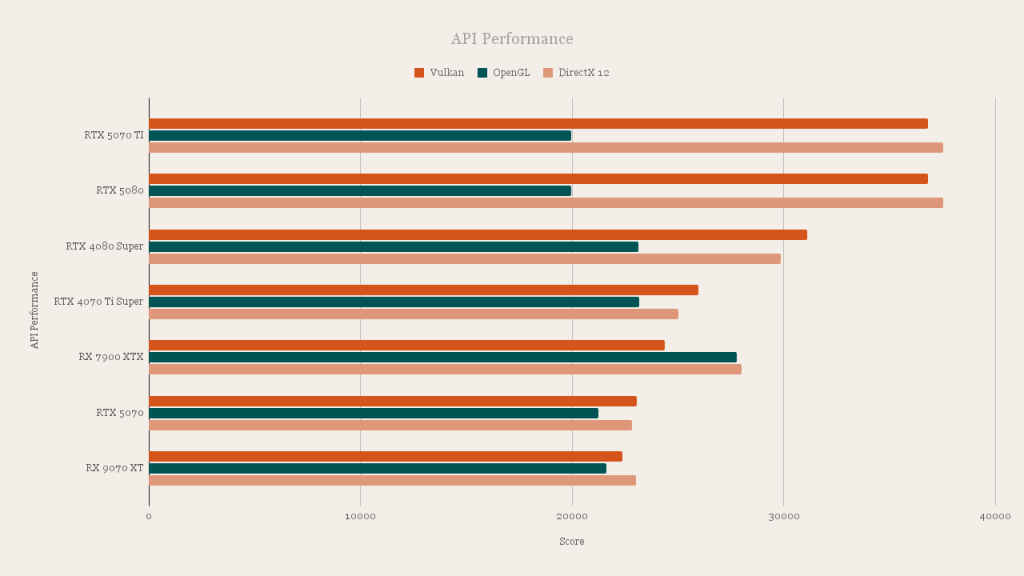
Procyon AI Computer Vision
The Procyon AI Computer Vision Benchmark evaluates the performance of AI inference engines on your hardware using a variety of machine-vision tasks and popular neural networks. The benchmark scores reflect the performance of on-device inferencing operations compared to the same operations run on the CPU or GPU. This allows you to measure the performance of AI accelerators and compare different AI inference engines from various vendors.
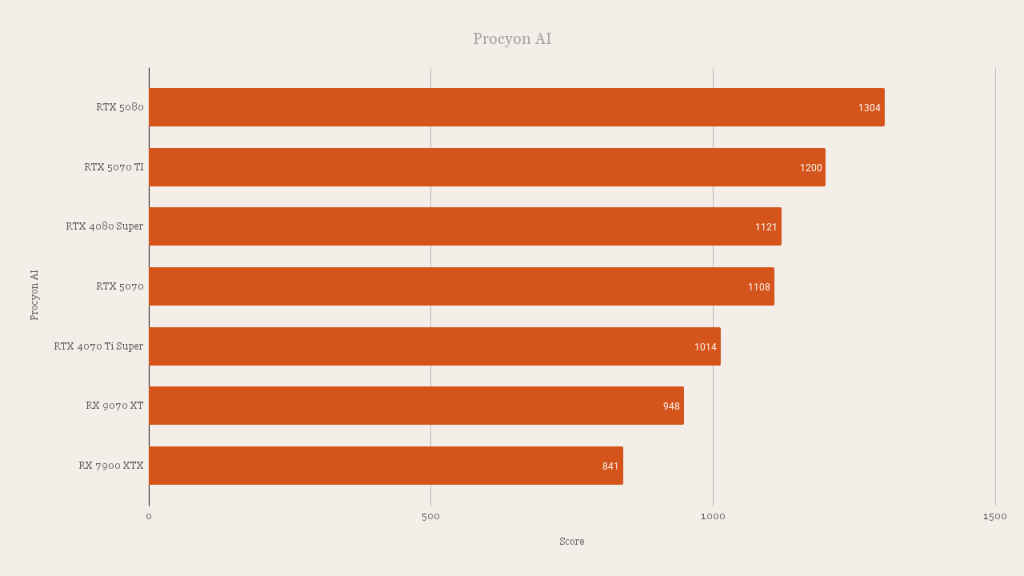
AMD Radeon RX 9070 XT Gaming Benchmarks
Assassin’s Creed Mirage
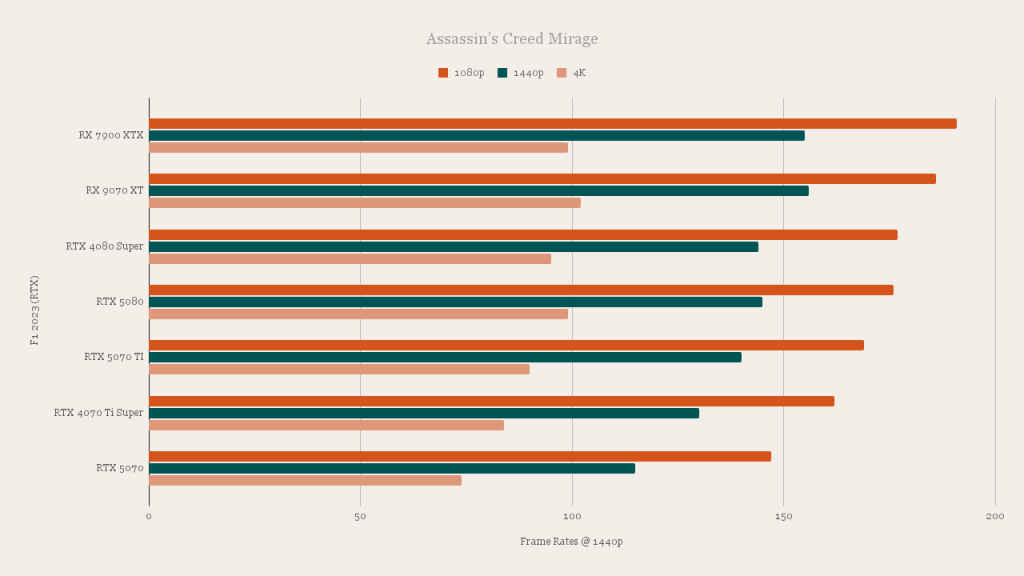
Hogwarts Legacy
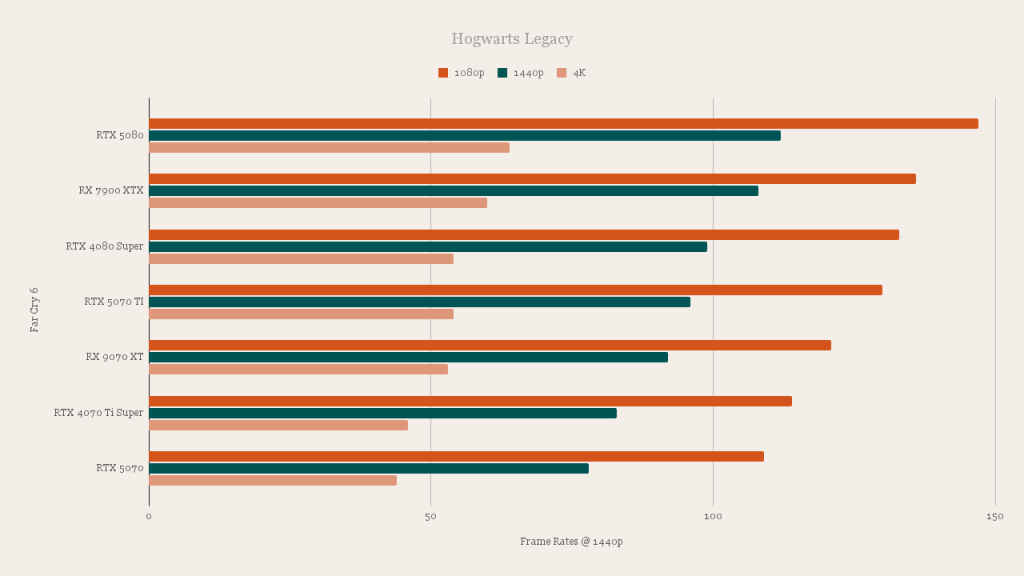
Cyberpunk 2077
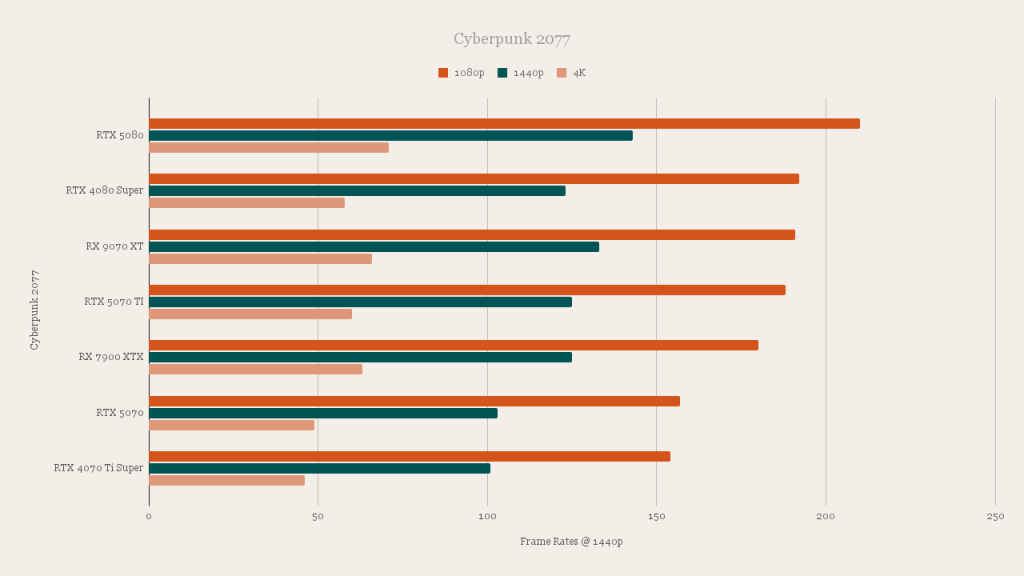
The Witcher 3
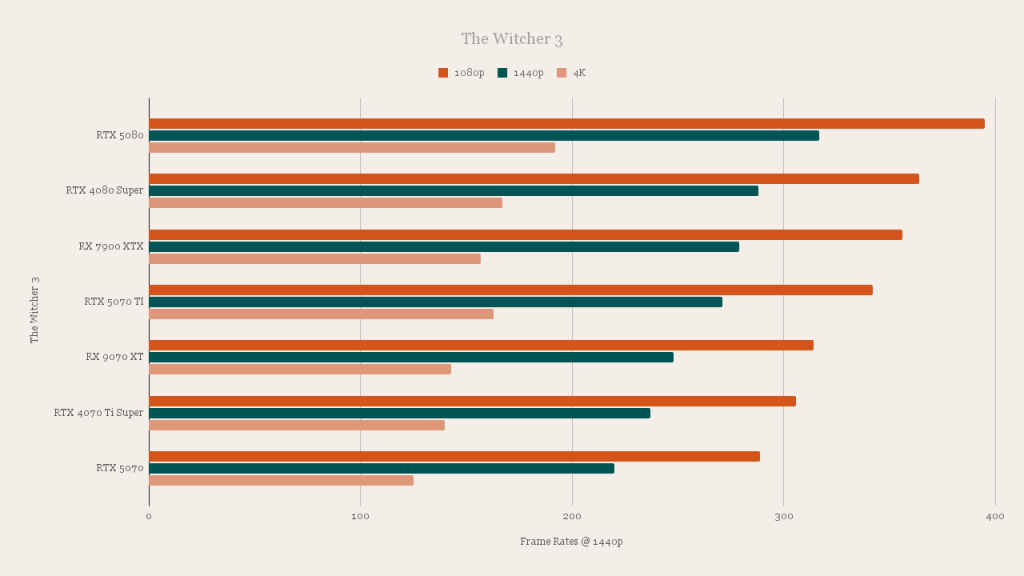
F1 24
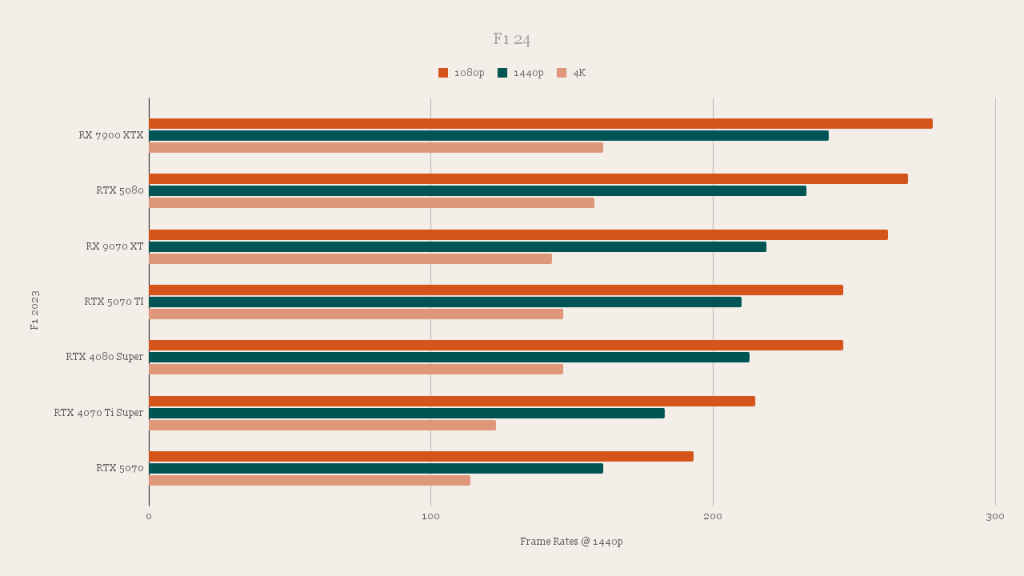
Power Consumption and Thermals
So what’s the secret behind the improved performance of the AMD Radeon RX 9070 XT? Ridiculous power consumption! Peak power draw on the Radeon RX 9070 XT can hit about 400 Watts during gaming and even more so if you push all the paddles, which in comparison to the 300 Watts of the RTX 5070 Ti and the 250 Watts on the RTX 5070 is quite inflated.
We found the Sapphire PURE RX 9070 XT to remain relatively cool during gaming with peak temperatures on the GPU barely hitting 60 degrees Celsius. However, the memory chips seem to be constantly running at 90 degrees Celsius which is quite high.
Overclocking the AMD RX 9070 XT
With clock speeds touching 3 GHz and power consumption also crossing into the 400 Watt territory, there isn’t much headroom to push the card. We got 103 MHz above the default clock speeds but the synthetic performance dropped by a meagre amount. For the unit we received, it was better off to leave the card at the factory overclock settings rather than mess around with the clock speeds.
Verdict
The Sapphire AMD Radeon RX 9070 XT graphics card is a powerful graphics card that offers excellent performance for 4K gaming and content creation. Based on AMD’s latest RDNA 4 architecture, the 9070 XT enjoys significant improvements in efficiency and performance over the previous generation RDNA 3 architecture. However, the compute efficiency comes at a tradeoff with power consumption and that’s quite high on the 9070 XT. Nevertheless, with 16 GB of VRAM on a 256-bit interface, improved ray-tracing performance and raster performance that matches and even beats the 7900 XTX, the Radeon 9070 XT has become a force to be reckoned with. If priced right at around INR 60,000 to 65,000, it offers excellent 4K gaming performance for the money. So if you’re looking for an upper-mid-range graphics card that won’t break the bank, the RX 9070 XT is a great option but if this card is priced anywhere above 80-85K then the NVIDIA RTX 5070 Ti becomes the better option considering that the performance-per-watt metric shifts in NVIDIA’s favour.
Mithun Mohandas
Mithun Mohandas is an Indian technology journalist with 14 years of experience covering consumer technology. He is currently employed at Digit in the capacity of a Managing Editor. Mithun has a background in Computer Engineering and was an active member of the IEEE during his college days. He has a penchant for digging deep into unravelling what makes a device tick. If there's a transistor in it, Mithun's probably going to rip it apart till he finds it. At Digit, he covers processors, graphics cards, storage media, displays and networking devices aside from anything developer related. As an avid PC gamer, he prefers RTS and FPS titles, and can be quite competitive in a race to the finish line. He only gets consoles for the exclusives. He can be seen playing Valorant, World of Tanks, HITMAN and the occasional Age of Empires or being the voice behind hundreds of Digit videos. View Full Profile
